The Antikythera Mechanism was recovered in about 1901 and is believed to date from about 200 BC. Its complicated gear mechanism is believed to have been used to generate calendars or predict astronomical events. The technology never spread to benefit ordinary people. It was forgotten and mechanical gears had to be re-invented.
The Antikythera Mechanism raises a question: how is it that technologies with the potential to benefit humankind can fail to be adopted? This issue of the causes of technology adoption is an important issue for economic growth.
(p. D3) A riddle for the ages may be a small step closer to a solution: Who made the famed Antikythera Mechanism, the astronomical calculator that was raised from an ancient shipwreck near Crete in 1901?
. . .
. . . a new analysis of the dial used to predict eclipses, which is set on the back of the mechanism, provides . . . another clue to one of history’s most intriguing puzzles. Christián C. Carman, a science historian at the National University of Quilmes in Argentina, and James Evans, a physicist at the University of Puget Sound in Washington, suggest that the calendar of the mysterious device began in 205 B.C., just seven years after Archimedes died.
. . .
Starting with the ways the device’s eclipse patterns fit Babylonian eclipse records, the two scientists used a process of elimination to reach a conclusion that the “epoch date,” or starting point, of the Antikythera Mechanism’s calendar was 50 years to a century earlier than had been generally believed.
. . .
. . . Archimedes was killed by a Roman soldier in 212 B.C., while the commercial grain ship carrying the mechanism is believed to have sunk sometime between 85 and 60 B.C. The new finding suggests the device may have been old at the time of the shipwreck, but the connection to Archimedes now seems even less likely.
An inscription on a small dial used to date the Olympic Games refers to an athletic competition that was held in Rhodes, according to research by Paul Iversen, a Greek scholar at Case Western Reserve University.
“If we were all taking bets about where it was made, I think I would bet what most people would bet, in Rhodes,” said Alexander Jones, a specialist in the history of ancient mathematical sciences at New York University.
For the full story, see:
JOHN MARKOFF. “On the Trail of an Ancient Mystery.” The New York Times (Tues., NOV. 25, 2014): D3.
(Note: ellipses added.)
(Note: the online version of the story has the date NOV. 24, 2014.)



